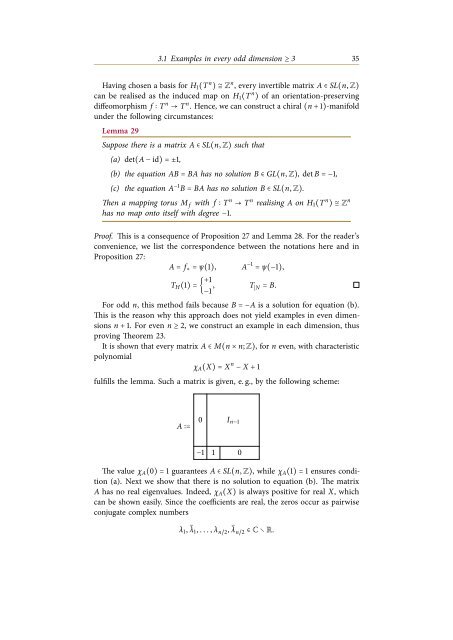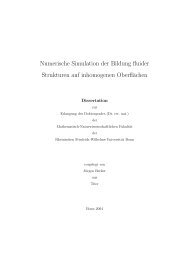Orientation reversal of manifolds - Universität Bonn
Orientation reversal of manifolds - Universität Bonn
Orientation reversal of manifolds - Universität Bonn
You also want an ePaper? Increase the reach of your titles
YUMPU automatically turns print PDFs into web optimized ePapers that Google loves.
3.1 Examples in every odd dimension ≥ 3 35<br />
Having chosen a basis for H 1 (T n ) ≅ Z n , every invertible matrix A ∈ SL(n, Z)<br />
can be realised as the induced map on H 1 (T n ) <strong>of</strong> an orientation-preserving<br />
diffeomorphism f ∶ T n → T n . Hence, we can construct a chiral (n + 1)-manifold<br />
under the following circumstances:<br />
Lemma 29<br />
Suppose there is a matrix A ∈ SL(n, Z) such that<br />
(a) det(A − id) = ±1,<br />
(b) the equation AB = BA has no solution B ∈ GL(n, Z), det B = −1,<br />
(c) the equation A −1 B = BA has no solution B ∈ SL(n, Z).<br />
Then a mapping torus M f with f ∶ T n → T n realising A on H 1 (T n ) ≅ Z n<br />
has no map onto itself with degree −1.<br />
Pro<strong>of</strong>. This is a consequence <strong>of</strong> Proposition 27 and Lemma 28. For the reader’s<br />
convenience, we list the correspondence between the notations here and in<br />
Proposition 27:<br />
A = f ∗ = ψ(1), A −1 = ψ(−1),<br />
T H (1) = { +1<br />
−1 , T ∣N = B.<br />
For odd n, this method fails because B = −A is a solution for equation (b).<br />
This is the reason why this approach does not yield examples in even dimensions<br />
n + 1. For even n ≥ 2, we construct an example in each dimension, thus<br />
proving Theorem 23.<br />
It is shown that every matrix A ∈ M(n × n; Z), for n even, with characteristic<br />
polynomial<br />
χ A (X) = X n − X + 1<br />
fulfills the lemma. Such a matrix is given, e. g., by the following scheme:<br />
A ∶=<br />
0 I n−1<br />
−1 1 0<br />
The value χ A (0) = 1 guarantees A ∈ SL(n, Z), while χ A (1) = 1 ensures condition<br />
(a). Next we show that there is no solution to equation (b). The matrix<br />
A has no real eigenvalues. Indeed, χ A (X) is always positive for real X, which<br />
can be shown easily. Since the coefficients are real, the zeros occur as pairwise<br />
conjugate complex numbers<br />
λ 1 , ̅λ 1 , . . . , λ n/2 , ̅λ n/2 ∈ C ∖ R.





